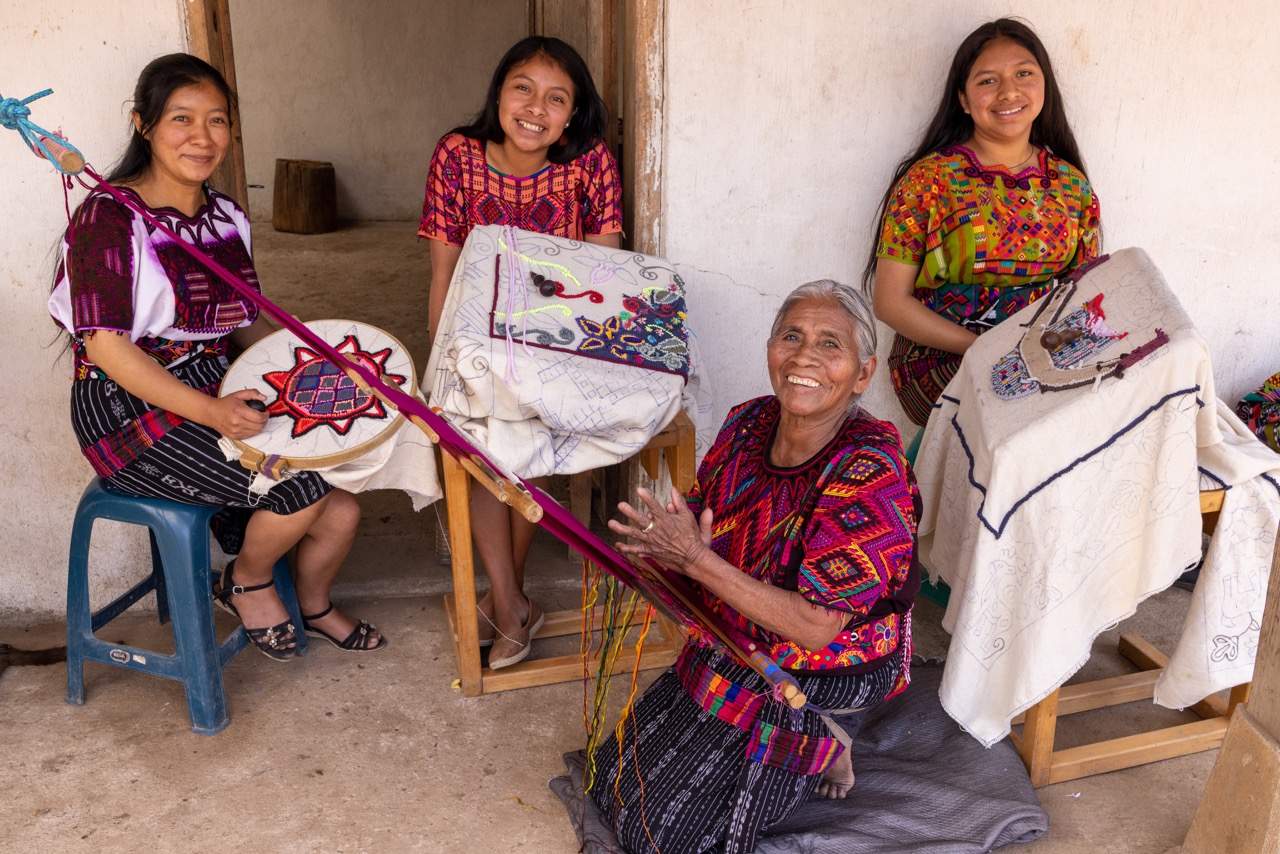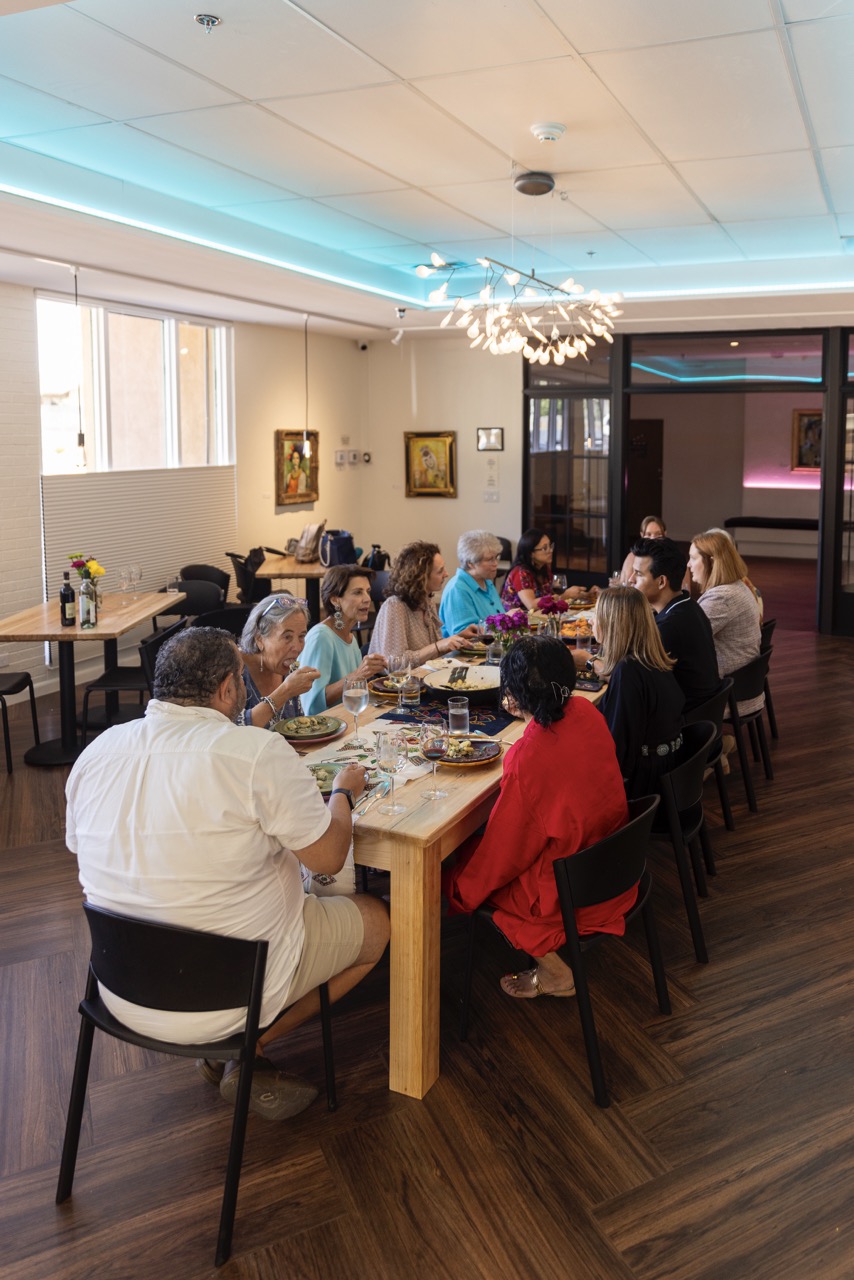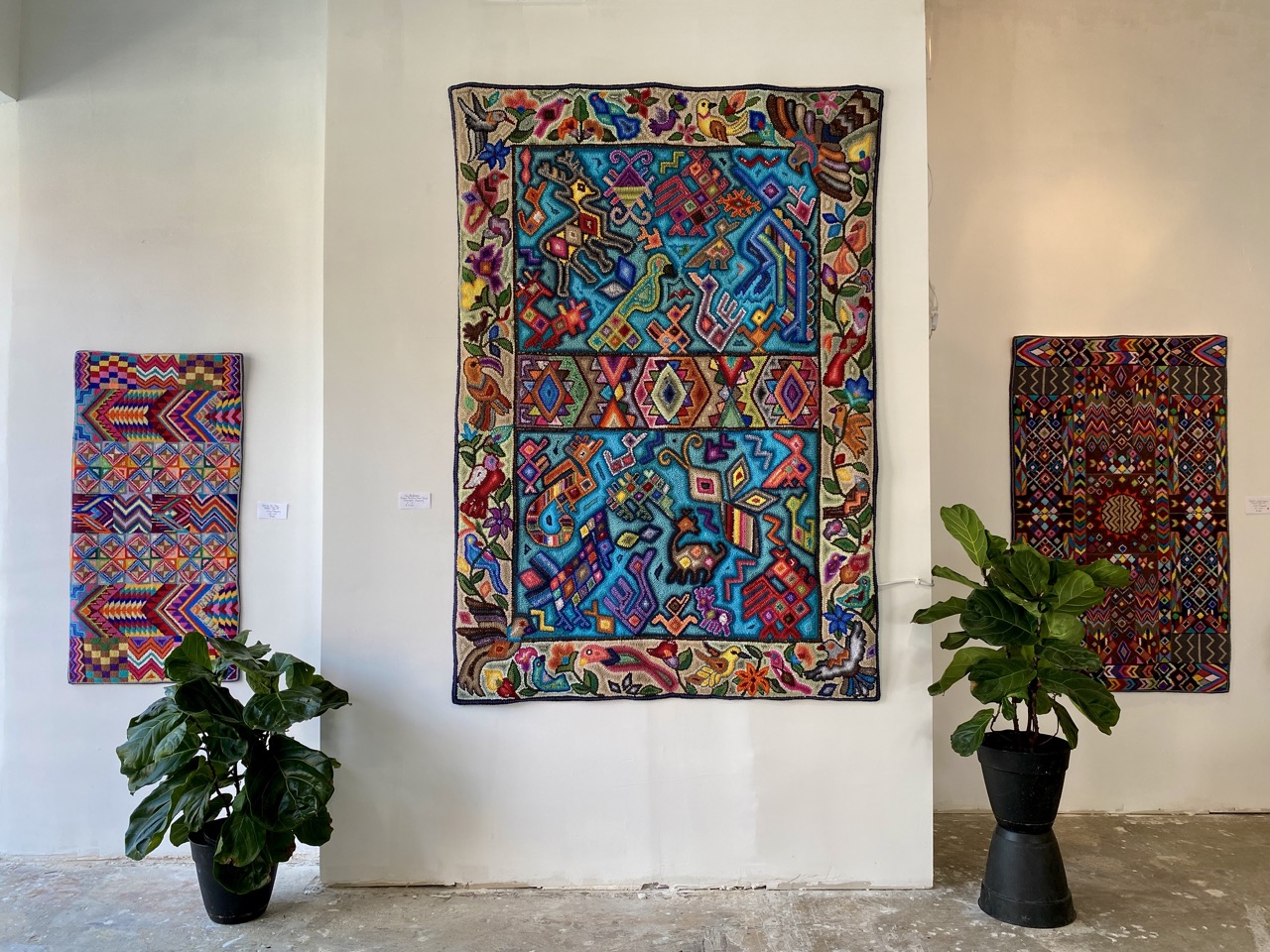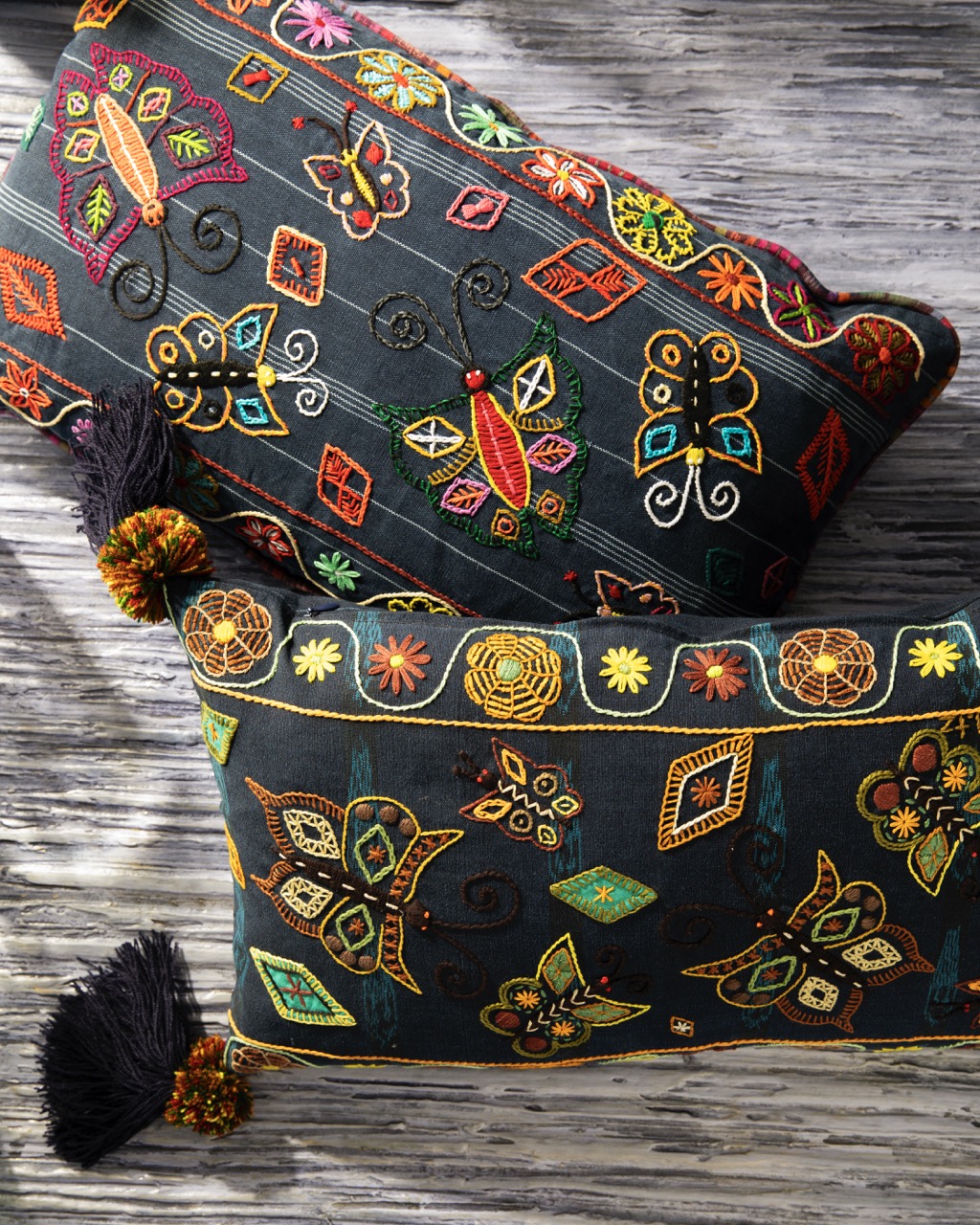As the International Folk Art Market celebrates 20 years, Mary Littrell looks at how the lives of Guatemalan rug makers, Multicolores have fundamentally improved because of their market participation. In their tenth showing this year at IFAM, Multicolores debuts their new embroidery project.

The Importance of The International Folk Art Market
“The International Folk Art Market (IFAM) is essential to our origin story,” says Cheryl Conway-Daly, executive director of Multicolores, a Guatemalan rug-hooking cooperative. “With the sales from our first year in 2014, we were finally able to move our activities out of a cramped bedroom and pay rent on an office for the first time.”
In the early 2000s, Guatemalan weavers were desperate for income to support their families. Sales to tourists of the women’s back-strap woven bags, belts, and placemats waned. Orders from fair-trade retailers demanded weaving to specifications rather than fostering product innovation.

Weighing the Economy
Master US rug designer, Mary Anne Wise, speculated whether the artisans’ reservoir of indigenous technical and creative proficiency could be applied to a high-quality, non-traditional, one-of-a-kind product that would sell in the US market. Her ensuing rug hooking classes generated new income prospects for the Guatemalan women. Rug hooking demanded few start-up costs: a hook, hoop, and cheaply available discarded clothes from the US that were imported and sold by paca vendors of second-hand clothing in Guatemala.
Initially, artists expressed skepticism, “Who will buy rugs made from old clothes?” Creative Director Reyna Pretzantzin says, “When the artists learned that we sold nearly every one of the 250 rugs we took to the first IFAM market, they realized that innovation in rug design was valued among IFAM’s customers.” Buyers also appreciated the use of recycled clothing in the vibrant designs.
Finding Likeminded Folk Artists
Reyna adds, “At the market, the Guatemala rug hookers were amazed that so many individuals around the world were creating textiles at such high levels.” The rug hookers began to envision themselves as part of a larger community of IFAM artists sharing their cultures and traditions and bringing income home to their communities. Reyna says, “community is so important.”

Over the next 10 years, multiple-year relationships emerged between artists and customers who returned. They bring their friends, buy more rugs, inquire about artists’ stories, and ask how Multicolores is doing. Mary Anne Wise says, “As a nonprofit, we had opportunities to meet people at the market who became donors to the organization. It turned into conversations that became lasting relationships.”
Invitations to trunk shows and exhibitions in galleries and museums followed. Multicolores rugs were selected for the American Embassy’s art collection in Guatemala City. Cheryl Conway-Daly says, “We could not have had those contacts without IFAM.”
Changing Lives One International Folk Art Market at a Time
Rug hookers identify a sustainable income as the most significant outcome for their lives. As other women in the artists’ communities observed the rug hookers’ lives improving in tangible ways—new water pipes, glass in the windows, a concrete floor—they asked to join the project.
Taking care that rug production not outpace the market, the Multicolores leaders wondered if their design curriculum could transfer to another medium: the embroidery practiced among neighboring women. Mary Anne says, “Our IFAM success with rugs gave us the confidence to work with another group of artists. The embroidery technique was already there, but our approach to design was new for them.” Visitors to the Multicolores booth at the upcoming 2024 IFAM will be the first to see the exquisite dolls and story cloths resulting from the 23 embroidery members of the recent offshoot design program.

Giving Back to the Community
With income from IFAM sales, donor support, and grants, Multicolores has established new initiatives for enhancing the lives of the artists and their communities. Medical clinics are offered in villages for Multicolores members and their families. In a mental health initiative, each artist can access a monthly, one-hour private session with a psychologist. The artists find these sessions a safe venue for talking about issues they cannot discuss with their families. They learn strategies for self-care, enhancing self-esteem, and resolving family conflicts. Artists also assess that the relaxation techniques learned from the psychologist contribute to greater concentration and enhanced creativity in their rug designs.
Other programs engage artists in acquiring skills for business and community leadership. In joining with office staff, selected artists are developing expertise related to the sale and promotion of their work—computer data entry, accounting, shipping, and taking product photos. Artists involved in community leadership sessions have focused on reforestation, enhancing community health, and participating in elections.
Looking back over Multicolores’ 10 years in IFAM, Cheryl Conway reports that sales have remained high with near- or completely sold-out booths at the end of each market. She reflects, “IFAM has become the barometer for validating our achievements, recognition, and confidence in artistic creativity.”

More Examples of The International Folk Art Market’s Positive Impact
Andrea and Ansula Usai, KOKKU, Italy
KOKKU’s first IFAM in 2014 launched a path toward saving Sardinia’s ancient craft of filigree metalwork. With expanded income, jewelers have unleashed their creativity with heightened motivation and joy as they create new collections of gold and silver jewelry.
Meeta Mastani, Bindaas Unlimited, India
IFAM has contributed to greater clarity in designing T-shirts that meet buyers’ demand. Each year, Bindaas has expanded its line of block-printed T-shirts with new bold, playful designs popular in Santa Fe. The innovations help keep traditional block printers in business.
Nilda Callañaupa Álvarez, Centro de Tetiles Tradicionale del Cusco (CTTC), Peru
Andean weavers have learned to expound on their artistic traditions to help buyers appreciate their colorful wool textiles. Market sales over 18 years have encouraged the weavers to explore ever more challenging weaving traditions from their historical past.
Olga Reiche, Indigo, Guatemala
Master Dyer Olga Reiche’s booth features handwoven huipiles in indigo and a range of natural dyes in pastel shades. Her eco-fashion brand, with its promise of ecological responsibility, finds favor with IFAM customers searching for handmade luxury garments.
Sanjar Nazarov, Uzbekistan
IFAM has assisted Sanjar in enhancing his knowledge of customers’ tastes for finely embroidered silk textiles. First offering only flat suzani textiles, he has expanded to bags, pillows, and a line of jackets and robes. His reaction to customer preferences has brought new attention to the Lakai origins of his designs.
Abduljabbar Khatri and Abdullah Khatri, SIDR Craft, India
Over 17 years in IFAM, SIDR Craft has grown from a small family workshop to a social enterprise. 300 women use their tying and dyeing skills of bandhani for gorgeous profucts. Creating for the global market motivates artists to further enhance their skills to produce high-quality scarves.
Story by Mary Littrell / Photography by Tira Howard, Joe Coca, and Susu Hauser
 Subscribe to TABLE Magazine‘s print edition.
Subscribe to TABLE Magazine‘s print edition.
